1 April 2016. Chemical engineers at Massachusetts Institute of Technology created a compact manufacturing system that produces small quantities of pharmaceuticals as needed. The system developed in the MIT labs of Alan Myerson, Klavs Jensen, and Timothy Jamison is described in the 31 March issue of the journal Science (paid subscription required).
Making drugs at commercial scale normally requires large amounts of materials often shipped from remote suppliers, large-scale facilities, and long production times to generate the quantities needed by customers. This batch production process may work for some prescription and over-the-counter drugs, but the industry still faces frequent spot shortages of pharmaceuticals — more than 200 per year, according to FDA — from variations in quality control and supply change interruptions.
Normal manufacturing processes are likewise not designed for small quantities or fast response. The long lead times make it difficult to respond quickly to natural disasters or other emergencies. In addition, the process does not work well for drugs needed in smaller quantities, such as those treating rare diseases or for clinical trials.
“The goal of this project,” says Jensen in an MIT statement, “was to build a small-scale, portable unit that was completely integrated, so you could imagine being able to ship it anywhere. And as long as you had the right chemicals, you could make pharmaceuticals.”
The authors’ manufacturing concepts are an outgrowth of a project with drug maker Novartis to develop a continuous flow process for drug manufacturing in a small-scale pilot facility that produced finished products from intermediate-stage chemicals. This new initiative, funded by Defense Advanced Research Projects Agency or Darpa, adds new processes for synthesis, purification, and formulation, with each process in a separate module. It also shrinks the size of the production facility to 1.0 by 0.7 by 1.8 meters, about the size of a home refrigerator.
A critical feature of the system is its use of tubes instead of large vats for the chemical reactions for drug production, which generate a lot of heat in the synthesis phase. Cooling the large vats is a challenge at many drug manufacturing plants, but a more manageable problem with the smaller quantities flowing through the tubes in the MIT prototype, even at temperatures of up to 250 degrees Celsius.
Purification of the product is done with crystallizing, followed by filtering and drying the product to remove solvents, then dissolving it in liquid to formulate the dosages. For this proof-of-concept, the team produced liquid drugs that meet U.S. Pharmacopeia standards. For solid formulations, such as tablets, additional steps, equipment, and space are needed, and the researchers are looking into miniaturization and 3-D printing for those processes.
With this platform, the team produced doses of the popular drugs diphenhydramine hydrochloride, lidocaine hydrochloride, diazepam, and fluoxetine hydrochloride — known by their brand names as Benadryl, Lidocaine, Valium, and Prozac respectively. The modular system design enabled the researchers to use the same technology, and swap out components to make each new batch, which they say could be done in a few hours.
The research team is now investigating adapting this platform to make more complex drugs, including solid-product formulations such as tablets, as well as shrinking its physical footprint further. In addition, first author and MIT research associate Andrea Adamo, founded the company Zaiput Flow Technologies in Cambridge, Massachusetts to commercialize liquid extraction and separation processes used in continuous flow chemistry.
Read more:
- Process Devised for Plastics from Carbon Dioxide, Plants
- What it Takes to Innovate in the Old Economy
- Manufacturing Process Devised for Skin-Patch Electronics
- GE, Institute to Design Digital Manufacturing Platform
- AstraZeneca Building New Biologics Plant
* * *


 RSS - Posts
RSS - Posts
[…] On-Demand Pharma Manufacturing System Developed […]